Airport lighting, to be used to guide and inform pilots, can vary widely from one airport to the next.
First, high-volume commercial and international airports have a variety of lighting systems to guide aircraft to the touchdown point, and to control ground traffic approaching the runways via taxiways.
Smaller municipal, county, and private airports will typically have simpler systems.
Pilots must be familiar with the various types of runway lighting systems.
Pilots who have trained at smaller general aviation airports may only see a few examples of basic runway lighting.
All airports intended for night takeoffs and landings must provide basic runway lighting for pilots.
The following are brief descriptions of various types of lighting that you’ll see at major airports, including (click to jump to a description):
- Runway Edge Lights
- Runway End Identifier Lights (REIL’s)
- Visual Approach Slope Indicator Lights (VASI)
- Approach Lighting System (ALS)
- Runway Threshold Lights
- Touchdown Zone Lighting (TDZL)
- Taxiway Centerline Lead Off-On Lights
- Land and Hold Short Lights (LAHSO)
- Runway Status Lights
- Taxiway Edge and Centerline Lights
Below, we’ll discuss what all of these mean, their colors, and other pertinent info.
Related Article – Runway Markings Explained
Runway Lights Explained
Runway Edge Lights
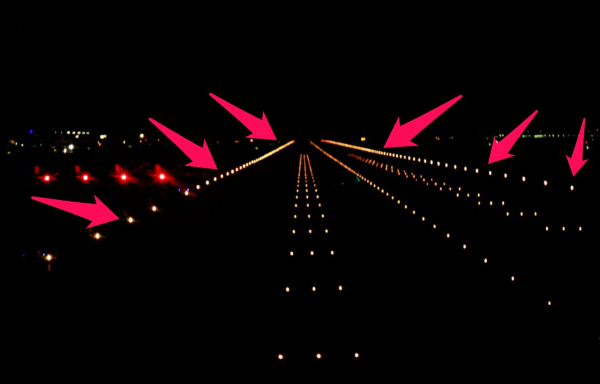
Many small airports may have only runway edge lights—white lights located just beyond the edge of the runways surface; and there are many sod runways with edge lighting.
From the air, at night, they are the familiar white lights that define the width and length of the runway.
At larger airports, these may be embedded in the pavement of the runway.
For runways served with an instrument approach, the last 2000 feet of runway edge lights are yellow.
Runway End Identifier Lights (REIL)
REIL lights are often used at smaller airports instead of Runway Threshold lights to identify the approach end of the runway.
The system consists of a pair of synchronized flashing lights located on each side of the runway threshold.
REILs are useful for identifying the approach end of a runway for pilots unfamiliar with an airport, and for runway location in reduced visibility.
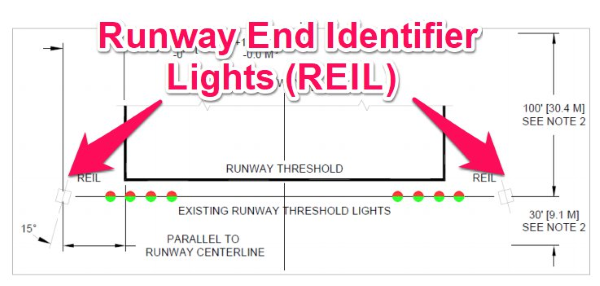
Figure 1. Runway End Identifier Lights (White Flashing—Red Arrows) (A quick Refernece to Airfield Stanards, Page 14)
Runway Centerline Lights
As the name suggests, Runway Centerline Lights are embedded lights, 50 feet apart, in the centerline of runways served by an instrument approach (Figure 2 below).
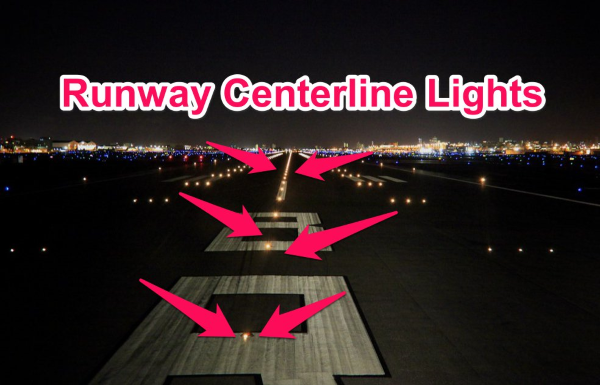
The centerline lights are white until the last 3,000 feet of the runway.
At 3000 feet remaining, they become alternating white and red; then become all red for the last 1000 feet of runway.
These lights are in protected assemblies that are slightly raised above the runway surface; rolling directly over them creates a bumpy ride.
Runway Approach Lighting Explained
Visual Approach Slope Indicator (VASI)
Some aircraft lighting is used to assist pilots in maintaining a typical glide path to the touchdown area of the runway.
VASI installations are one of the simplest, most effective aids to landing available.
In its simplest form VASI’s consists of two pairs of panels, both with red and white lighting; one pair set behind the other.
When the aircraft is established on a typical 3-degree glide slope to the runway, the pilot will see the red panels over (behind) the white panels.
If the aircraft is below the glide slope, both sets of panels will be red; above the glide slope both panels will be white (See Figure 3).
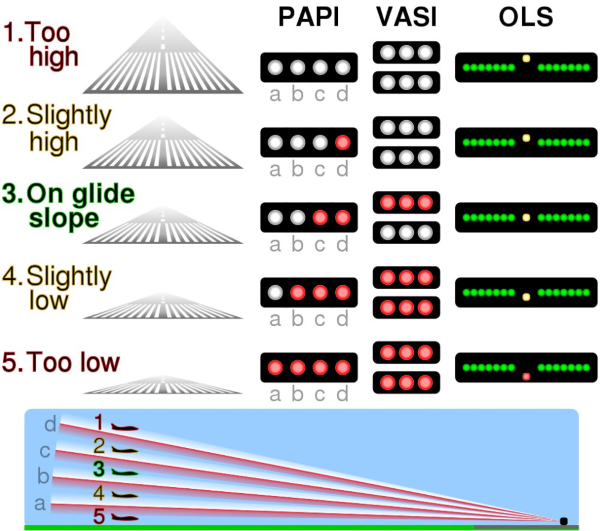
There are several variations on VASI installations that include more panels or three rows of panels for special applications (for more information, see AIM, 10-12-17, Section 2-1-2, Page 2-1-3).
At night, the VASI may be visible up to 20 miles.
Descent using the VASI should not be initiated until the aircraft is aligned with the runway.
Approach Light Systems (ALS)
Arriving at an airport, especially when operating in reduced visibilities, may require transitioning from instrument flight to visual cues.
ALS systems are engineered for each airport installation.
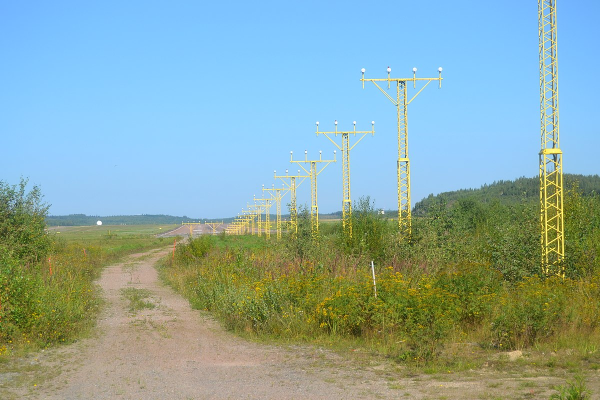
There are two general patterns for standard ALS approaches; one for Category II-plus runways, and Category I runways.
The ALS is a configuration of signal lights that begin at the landing threshold and extend outward, 1500 to 3000 feet.
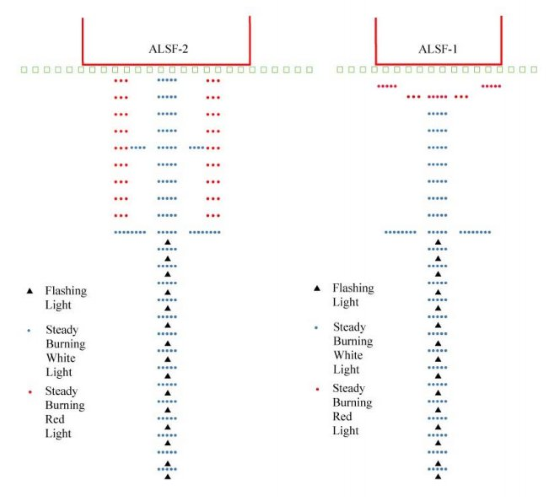
Some systems include sequenced flashing strobe lights that create the appearance of a ball of light leading the pilot to the runway.
In denser instrument meteorological conditions, the sequenced strobe may be the first element of the system visible to the pilot.
Runway Threshold Lights
Runways served by instrument approaches often have a row of green lights that identify the landing threshold (see Figure 6).
These are especially useful for identifying a displaced threshold.
When on the runway, the threshold lights at the far or departure end of the runway are red alerting pilots that the end is approaching.
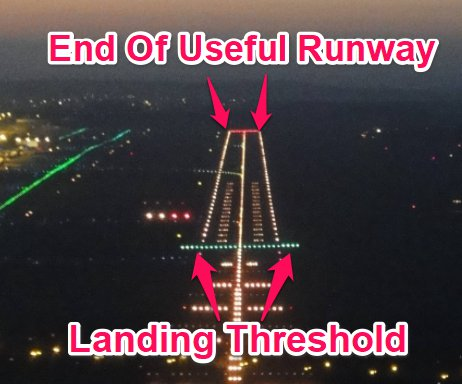
Touchdown Zone Lighting (TDZL)
Touchdown zone lights are installed on some precision approach runways to indicate the landing area when landing in reduced visibility conditions (Figure 7).
They consist of two rows of “transverse light bars” symmetrically placed across the runway centerline.
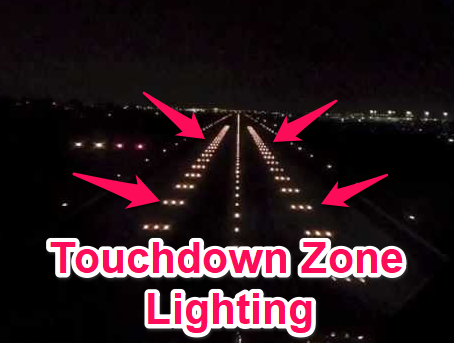
The light bars are steady-burning white lights that start 100 feet beyond the landing threshold and extend to 3,000 feet beyond the landing threshold or to the midpoint of the runway, whichever is less.
Taxiway Lighting Explained
Taxiway Centerline Lead-Off Lights
Taxiway centerline lead-off lights provide visual guidance to pilots exiting the runway (Figure 8).
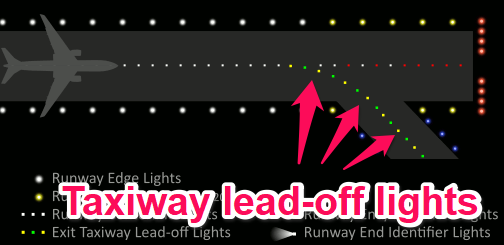
They are color-coded to warn pilots and vehicle drivers that they are within the runway environment or instrument landing system (ILS) critical area, whichever is more restrictive.
Alternate green and yellow lights are installed, beginning with green, from the runway centerline to one centerline light position beyond the runway holding position or ILS critical area holding position.
Taxiway Centerline Lead-On Lights
Taxiway centerline lead-on lights provide visual guidance for pilots entering the runway.
These “lead-on” lights are color-coded with the same color pattern as lead-off lights to warn pilots and vehicle drivers that they are within the runway environment or instrument landing system (ILS) critical area.
The fixtures used for lead-on lights are bidirectional, i.e., one side emits light for the lead-on function while the other side emits light for the lead-off function.
Any fixture that emits yellow light for the lead-off function must also emit yellow light for the lead-on function (Figure 9).
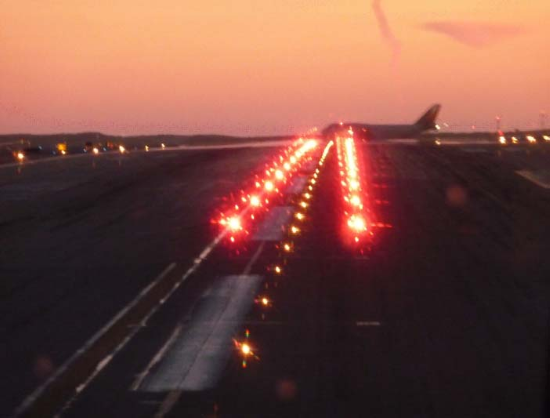
Land and Hold Short Lights
Land and hold short lights are used to indicate the hold short point on certain runways that are approved for Land and Hold Short Operations (LAHSO).
This system will work only if pilots have a clear understanding of what LAHSO is and how to use it.
In Figure 10, the aircraft to the right has been cleared to “land and hold short” of the crossing runway at or before the LAHSO line, “B.”
Pilots are expected to know that they will be able to land and stop in the available distance.
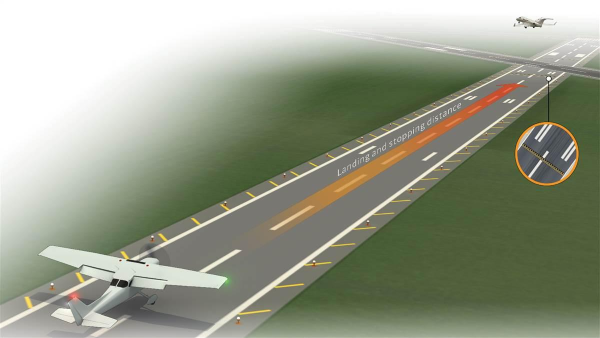
Land and hold short lights consist of a row of pulsing white lights installed across the runway at the hold short point (B).
Where installed, the lights will be on anytime LAHSO is in effect. These lights will be off when LAHSO is not in effect.
Runway Status Lights
The Runway Status Lights (Figure 11) are a relatively new system to enhance operations by alerting aircraft on intersecting runways and taxiways of potential hazards of aircraft or other vehicles crossing in front of them.
Typically, the hazards are brief—15 to 30 seconds while the vehicle passes with enough time to not actually be a hazard to the aircraft on the crossing runway.
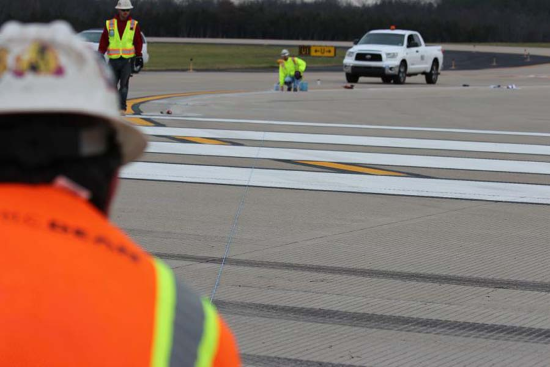
The RWSL system is an automated system, automatically activated by sensors on the runways and taxiways.
RWSL is a system of lights embedded in or adjacent to a runway that provide control guidance to pilots and include:
- Runway Entrance Lights (REL)
- Takeoff Hold Lights (THL)
- Runway Intersection Lights (RIL)
- Final Approach Runway Occupancy Signal (FAROS)
The Runway Entrance Lights are run from a hold line to the edge of a runway.
These are flush mounted, and alert pilots that there is high-speed traffic approaching or on the runway that will cross in front of the waiting aircraft.
They are NOT controlled by ATC (e.g., Control Tower or Approach control).
They are activated by aircraft or vehicles operating on conflicting runways to alert aircraft on crossing runways or entering a runway from a taxiway.
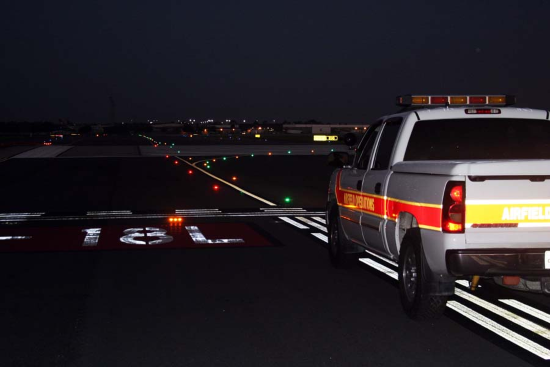
If there appears to be a conflict between the RWSL and the pilot’s operation, the pilot should contact ATC as soon as possible to resolve the conflict.
When the RWSL is extinguished, it is NOT a clearance to proceed onto a runway from the taxiway or across the runway without ATC clearance.
The RWSL system was planned for 23 US airports by 2018.
Related Article – 14 Taxiway Markings, Signs, and Lights Explained
Taxiway Lighting
Taxiways also have defined colors for different parts and positions on taxiways.
Taxiway Edge Lights
Blue lights outline the edges of taxiways around the airport.
Guidance to and from runways is provided by lighted signs and arrows.
Lights may be elevated lights beside the edges of the taxiways or embedded in the pavement.
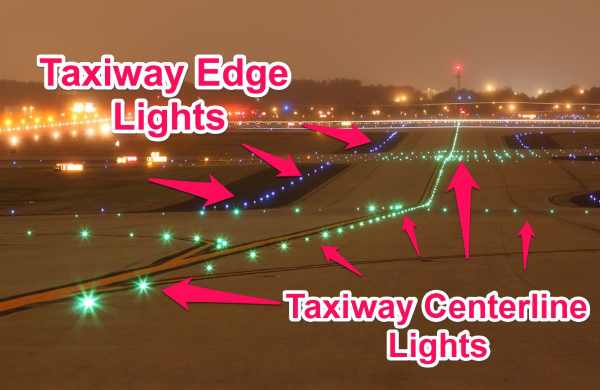
Taxiway Centerline Lights
Where taxiway centerlines are lighted, they are steady burning green lights located along the taxiway centerline.
Where a taxiway crosses a runway, or where a “lead-off” taxiway centerline leads off a runway to join a taxiway, the center line lights will be alternating green and yellow.
Hold/Clearance Bar Lights and Runway Guard Lights
Yellow lights are used to define a holding position at a taxiway intersection or at the holding position before entering the runway.
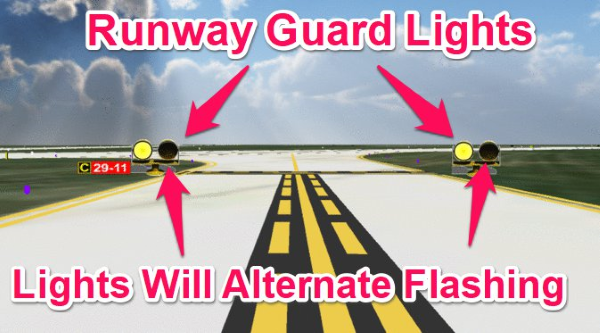
Lights may be elevated flashing lights off to the sides of the taxiway, or a line of embedded yellow lights in the pavement.
Stop Bar Lights
At the runway holding position, there will be a row of red, unidirectional, steady-burning in-pavement lights installed across the entire taxiway at the runway holding position, as well as elevated steady-burning red lights on each side to be used in low visibility conditions. (below 1,200 ft RVR).
When cleared to enter or cross a runway, these will be turned off.
If available, lead-on lights will be illuminated.
Quick Guide to Airport Lighting Colors and Patterns
Figure 12. Lighting colors associated with airport lighting systems (Source: FAA).
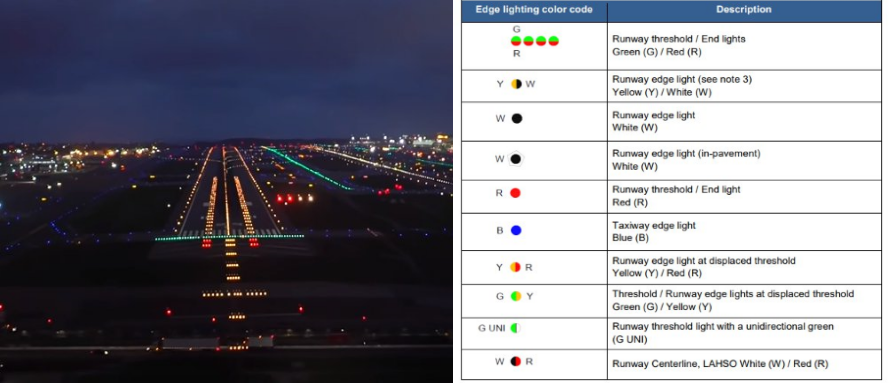
The table above shows the lighting color symbols and associated runways and approach lighting systems.
Notes:
1. Light fixtures for the lights identified in the color code chart are specified in AC 150/5345-46.
2. White lights are shown as black.
3. For an instrument runway, yellow runway edge lights are installed on the last 2000 ft. or one-half the runway length, whichever is less.
References

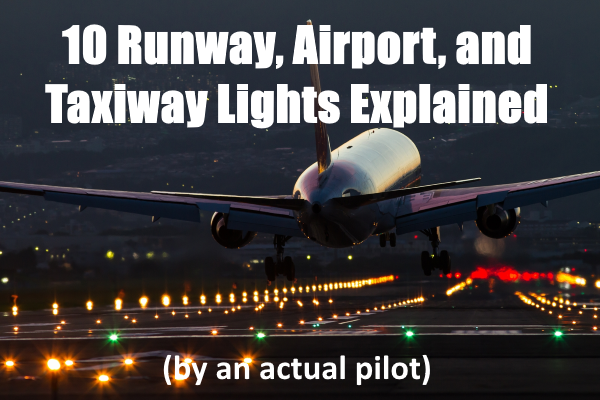

Great article!